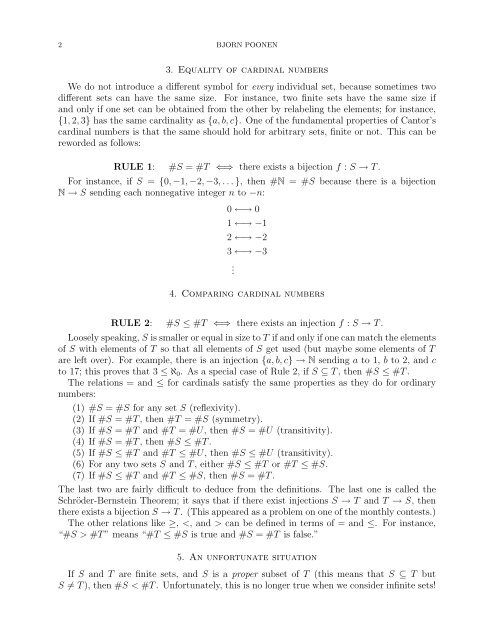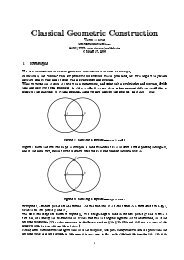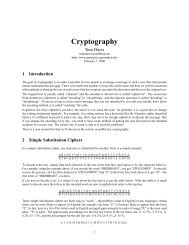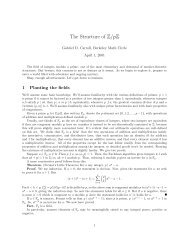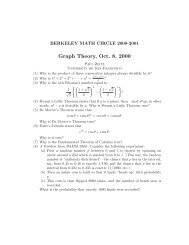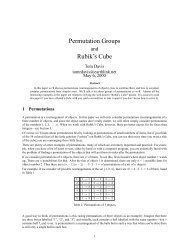INFINITY: CARDINAL NUMBERS 1. Some terminology of set theory ...
INFINITY: CARDINAL NUMBERS 1. Some terminology of set theory ...
INFINITY: CARDINAL NUMBERS 1. Some terminology of set theory ...
You also want an ePaper? Increase the reach of your titles
YUMPU automatically turns print PDFs into web optimized ePapers that Google loves.
2 BJORN POONEN<br />
3. Equality <strong>of</strong> cardinal numbers<br />
We do not introduce a different symbol for every individual <strong>set</strong>, because sometimes two<br />
different <strong>set</strong>s can have the same size. For instance, two finite <strong>set</strong>s have the same size if<br />
and only if one <strong>set</strong> can be obtained from the other by relabeling the elements; for instance,<br />
{1, 2, 3} has the same cardinality as {a, b, c}. One <strong>of</strong> the fundamental properties <strong>of</strong> Cantor’s<br />
cardinal numbers is that the same should hold for arbitrary <strong>set</strong>s, finite or not. This can be<br />
reworded as follows:<br />
RULE 1: #S = #T ⇐⇒ there exists a bijection f : S → T .<br />
For instance, if S = {0, −1, −2, −3, . . . }, then #N = #S because there is a bijection<br />
N → S sending each nonnegative integer n to −n:<br />
0 ←→ 0<br />
1 ←→ −1<br />
2 ←→ −2<br />
3 ←→ −3<br />
.<br />
4. Comparing cardinal numbers<br />
RULE 2: #S ≤ #T ⇐⇒ there exists an injection f : S → T .<br />
Loosely speaking, S is smaller or equal in size to T if and only if one can match the elements<br />
<strong>of</strong> S with elements <strong>of</strong> T so that all elements <strong>of</strong> S get used (but maybe some elements <strong>of</strong> T<br />
are left over). For example, there is an injection {a, b, c} → N sending a to 1, b to 2, and c<br />
to 17; this proves that 3 ≤ ℵ0. As a special case <strong>of</strong> Rule 2, if S ⊆ T , then #S ≤ #T .<br />
The relations = and ≤ for cardinals satisfy the same properties as they do for ordinary<br />
numbers:<br />
(1) #S = #S for any <strong>set</strong> S (reflexivity).<br />
(2) If #S = #T , then #T = #S (symmetry).<br />
(3) If #S = #T and #T = #U, then #S = #U (transitivity).<br />
(4) If #S = #T , then #S ≤ #T .<br />
(5) If #S ≤ #T and #T ≤ #U, then #S ≤ #U (transitivity).<br />
(6) For any two <strong>set</strong>s S and T , either #S ≤ #T or #T ≤ #S.<br />
(7) If #S ≤ #T and #T ≤ #S, then #S = #T .<br />
The last two are fairly difficult to deduce from the definitions. The last one is called the<br />
Schröder-Bernstein Theorem; it says that if there exist injections S → T and T → S, then<br />
there exists a bijection S → T . (This appeared as a problem on one <strong>of</strong> the monthly contests.)<br />
The other relations like ≥, can be defined in terms <strong>of</strong> = and ≤. For instance,<br />
“#S > #T ” means “#T ≤ #S is true and #S = #T is false.”<br />
5. An unfortunate situation<br />
If S and T are finite <strong>set</strong>s, and S is a proper sub<strong>set</strong> <strong>of</strong> T (this means that S ⊆ T but<br />
S = T ), then #S < #T . Unfortunately, this is no longer true when we consider infinite <strong>set</strong>s!


